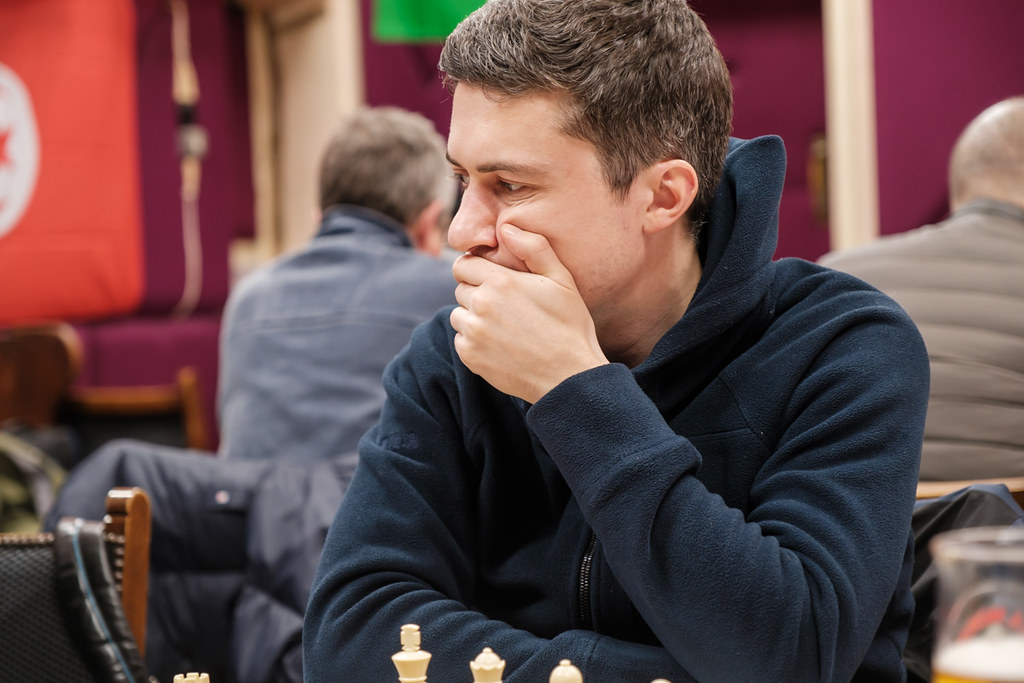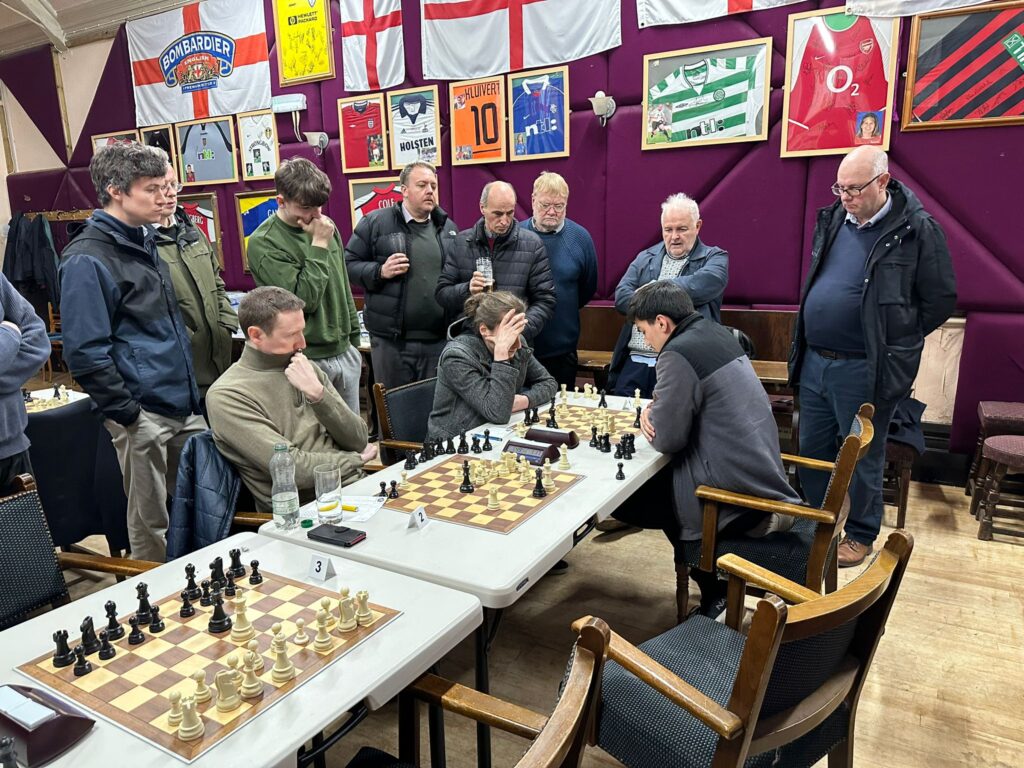In one evening, Kingston triumph in two leagues, after a gripping and decisive match with Hammersmith (played at the Willoughby Arms on 27 March 2023)
The fat lady worked overtime to sing twice for the Kingston first team on Monday – once at the Willoughby Arms and then again at the Guildford Institute. A memorable evening was followed, remarkably, by a memorable morning when we got the news from Guildford.
Before this match, we had been calculating what we needed to win Thames Valley League division 1. Two wins from our last four matches would ensure that we finished top, but if we beat Hammersmith at home we would become champions with three matches to spare, as then Hammersmith would not be able to catch us even if they won their final four matches. In the Surrey League we knew we needed just a draw at Coulsdon on 3 April to win that title.
Hammersmith, last season’s Thames Valley League champions, had given us a tough match at their venue, and they turned up at the Willoughby with another strong team. The top two pairings were the same as in the previous match, and altogether nine of the 12 players had participated in that fixture.
One who hadn’t was Hammersmith’s board 6, the junior Cian Ward. John Foley has found himself paired with several underrated juniors this season, and Cian proved his prowess by holding John to a draw in a Caro-Kann Two Knights variation. A quiet start, which totally belied the way the rest of the match would go.

On board 4 Will Taylor was playing the Hammersmith captain. This pairing surprised me, as almost every time I’ve played against Hammersmith I’ve found myself facing Bajrush Kelmendi. As a result, I think I know his game quite well. Will commented afterwards: “David Rowson gave me some useful intel before the game: my opponent plays quickly and aggressively. Normally I struggle against such players, as I have a tendency to get into time trouble, but at least I was psychologically prepared and tried not to fall too far behind on the clock.” As usual in Kelmendi’s games, his English Opening, far from being quiet and positional, was the prelude to a wild middlegame with the players attacking on opposite sides. In the position below Will played the imaginative 16…Nxc5.
Will’s attacking intent was commendable. “The point was lines like 17. dxc4 d4,” he explained, “but 18. Nd5! would have been a cold shower, blocking the e6-h2 diagonal and with it my attack. Qxd2 19. Nxf6+ gxf6 20. Rxd2. I’ll pick up another pawn, but it isn’t enough.” As it was, his opponent missed the opportunity, Will’s forceful play won the exchange, and he succeeded in co-ordinating his rooks to threaten checkmate and win the game. Only at the end of the evening did it become clear how important this was for us.
The next game to finish was my own. As quite often seems to happen, my beloved King’s Indian Attack did not live up to the last word of its name, and I found myself defending on the queenside and in the centre in a complicated game. My opponent’s passed c-pawn should have won for him. However, we reached this position:
Tired and under time pressure, I played 43. Nc6, overlooking 43…Rxc6 44. Bxc6 c2. For a few moments I thought I was lost and almost resigned, but then I saw 45. Bb5. He played Bf5, but I had 46. Bd7! Now Black either takes the bishop and ends up with two bishops against rook and pawn, or just repeats moves, as I will continue to move my bishop to a square where it diverts his own bishop from protecting the c2 pawn. An additional point is that if 46…Bxd7 47. Rxc2 Bxa4 I have 48. Rc4 winning one of the bishops. I thought my opponent might have played on, but he graciously offered a draw.
This made the score 2-1 to Kingston with the top three boards still in play. Peter Lalić transposed into the Mikėnas Defence (1. c4 Nc6 2.d4 e5) against Ali Hill’s English Opening, and after some original play from both sides had sacrificed his b-pawn for an advantage. Meanwhile, Vladimir Li, playing White against Carsten Pedersen’s usual French Defence, had won two pawns but was in a very complicated middlegame.
On board one, David Maycock v Marco Gallana, the Italian chose the Sveshnikov variation of the Sicilian Defence (1. e4 c5 2. Nf3 Nc6 3. d4 cxd4 4. Nxd4 Nf6 5. Nc3 e5). It’s impossible to do justice to this game in a few words. David revels in complications, and here he boldly sacrificed his h-pawn and calmly played his king to d2, into the midst of the maelstrom. Gallana had castled kingside, but this was also hardly a safe haven for his monarch as David’s rooks were lined up against it. The position after move 24 is shown below.
Here David played the very imaginative 25. Nf6+, to deflect Black’s bishop from defending h6. At this point, it seems to me, the limits of human analysis are pretty much exceeded and it’s even difficult to understand Stockfish’s analysis, according to which Marco’s 25…Bxf6 was a mistake (it says Kh8 is winning), but David’s follow-up, 26. Qxh6, should have given the advantage back to Black. The engine thinks 26. Ng4 instead was winning for White. I think the best way to get an understanding of what was going on in this amazing game would be to spend a club evening analysing it together.
Meanwhile, Vladimir had continued to play forcefully, but, short on time in a double rook endgame, he allowed his opponent to win back one pawn and exchange into a drawn single rook ending, a disappointment after his excellent play earlier on. His lesson to himself was “play simple chess when low on time”.
On balance, a point up at 2.5-1.5 with just the top two boards remaining, Kingston still looked favourites. Unfortunately, with less than five minutes on his clock on move 20, Peter Lalić overlooked that Ali Hill could win a piece. Peter only had two pawns for it, but he always knows how to keep setting problems for his opponent, even in the most unpromising positions. The position below was reached at move 40, with Peter three points down according to Stockfish.
There followed: 40. Rb3 Ke7 41. Bc6 Rb8 42. Ke2 f6 (creating a key passed pawn) 43. gxf6+ Kxf6 44. Kd3 Kg5 45. Rb1 b3 46. Rg1+ Kf4. It’s now equal according to Stockfish, because Black has been playing actively with his king and has two passed pawns, while White has not made any progress.
47. Rf1+ Kg3 48. Kc3 b2 49. Kc2 Kg2 50. Rb1 Kf3 51. Rxb2. Remarkably, Black now has winning chances.
Rxb2+ 52. Kxb2 g5 53. Kc3 g4 54. Bd7 g3 55. Bh3 g2. Here, 55…Kxe4 would have won, as Black wins the bishop for the g-pawn and then advances his e-pawn, subsequently winning White’s d-pawn, but Peter had only four seconds remaining. 56. Bxg2+ Kxg2 (now it’s a draw) 57. Kc4 Kf3 58. Kb5 Kxe4 59. Kc6 Kf5 60. Kxd6 e4 61. Kc7 e3 62. d6 e2 63. d7 e1=Q 64. d8=Q Qa5+ 65. Kc8 Qxd8+ 66. Kxd8 1/2-1/2 An amazing save by Peter under extreme time pressure.

Thus the top-board game was left to decide the match and, possibly, the league: a fitting, and gripping, ending. Kingston only needed a draw to win the match and be Thames Valley champions. Both players were now playing on the 10-second increment. As the spectators clustered round, David was in theory (according to Stockfish analysis) completely lost, but Marco missed a difficult mating sequence and suddenly it was David who had the better chances.
In the position above David played 32. Rxg6 and Marco took the rook with his knight. Instead 32…Qxe3 would have led to mate in eight. Following 32…Nxg6. 33. Qg8+ Black’s king was pushed to the other side of the board. But, pressing for a win, David lashed out unnecessarily with his rook, and after a flurry of moves this position was reached:
With almost no time left, Gallana played 41…Qc3+ 42. Kc1 Qe1+ 43.Kb2 Qc3+ and the players agreed a draw. In fact, Black didn’t need to repeat. Ba3+ is winning when the king retreats to c1, and the move also works if White unpins the knight by taking shelter on b1: 44. Kb1 Ba3 and White only has 45. Rd6+ to prevent mate. But after both David and Marco had fought so hard to negotiate a knife-edge position on 10-second increments alone, it seemed an appropriate ending.
So Kingston had achieved a last gasp win by 3.5-2.5. A memorable way to win the Thames Valley title, in such a close match against the previous champions. Hammersmith were worthy opponents; Chris Skulte even kindly helped me to finish packing up the equipment.
We were quietly luxuriating in this achievement when, the following morning, Kingston chair Alan Scrimgour noticed on the Surrey chess website that Guildford 1 had beaten Wimbledon 1 5-3 the previous evening. As Wimbledon was the only club which could hypothetically catch us until then, their defeat meant that Kingston were not only Thames Valley but also Surrey Trophy champions.
Two titles in one evening, and the first time this has ever been achieved by Kingston in the same season (emulating Wimbledon, who won both in 2018). The last time Kingston were champions of Surrey was 1975 and the last time the club won the Thames Valley League was 1984. Two very long waits ended on the same evening in what may be Kingston’s greatest ever season.
David Rowson, Kingston first-team captain



